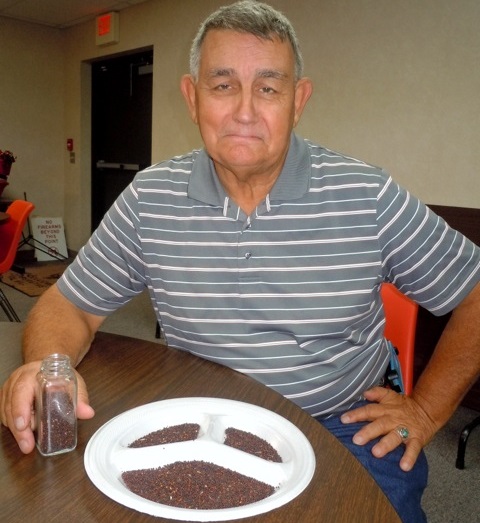
Agricultural News
Oklahoma Crop Consultant Ready for Fall Canola Planting
Thu, 04 Sep 2014 10:09:03 CDT

Respected and well-known for his expertise as a crop consultant in the US Southern Plains, Gene Neuens is concentrating on the upcoming winter canola planting season which begins this month. "Early planting has its pluses and minuses," Neuens, who has management of farm cooperatives and development of commodity marketing programs in his quiver of skills.
"Agronomic research tells us winter canola should be planted in a 30 day period between September 10 and October !0, he said.. "This period of time has proven to be best for giving the crop plenty of time to establish itself and grow well. September10-October 10 is also the suggested time to plant canola to be eligible for the USDA Risk Management Agency crop insurance program."
Neuens urges farmers to make sure their canola crop insurance applications have been turned in on time and to double-check with their insurance agents that all costs and fees have been paid. If producers haven't done so yet, he urges them to select a fertilization program established for canola and apply it as soon as possible.
"So far as soil moisture is concerned," he said. "lack of rain during August wasn't a good thing. Recent rains have been good in local areas with some fields having plenty of soil moisture and others not so good. Luckily, meteorologists predict rain for this weekend and then for the middle of next week."
On-going reports of a moderate El Nino bringing cooler temperatures and more rain to the Southern Plains this fall and winter is welcome news, he said. Like everyone in the business knows, he said, farming requires a lot of faith and determination to carry on.
The crop insurance package offered as a result of the 2014 Farm Bill has kept a lot of farmers in business who suffered big crop losses in winter wheat and canola during the last crop year, he said.
Neuens urges farmers who haven't selected the canola varieties they will plant this month to get busy and buy them.
"Farmers who have ordered their seed should pick it up from the seller to make sure they will have it," he said. "If it hasn't already happened, many seed varieties will soon become scarce or impossible to obtain."
While crop prices, for several reasons, are down right now, Neuens points out canola prices stay from $3-5 per bushels higher than winter wheat. Cash price for winter canola as of September 3, 2014, is $8.35 per bushel compared to $5.71 per bushel for winter wheat. While conjecture as to the size of the 2014-15 winter canola crop in the Southern Plains is building, Neuens maintains it is too early to state positively how many acres will be planted. He points out last season's extreme cold, dry winter followed on by the April freeze nearly wiped out both the winter wheat and canola crops. Crop insurance and the need to plant again on a succeeding crop year will probably bring a similar number of acres planted to winter canola, he said.
"Producers planted between 350,000 and 400,000 acres of winter canola in 2013," he said. "Unless there are some really big changes in what farmers intend to do, and it is a little late to change now, I think a similar number of acres will be planted this fall."
Winter canola requires a little more care and management than what is typically required for winter wheat, Neuens said. For producers who have not planted canola yet and for those who want to get a better handle on their planting skills, OSU and Great Plains Canola Association agronomists will hold educational sessions on how to set box drills, air seeders and planters from 9-11 a.m. September 8-16, he said. Calibration kits and procedure materials will be available at each of the four sessions which will be held September 8 at the OSU Caddo Research Station near Fort Cobb, September 11 at the Kingfisher County Fairgrounds, September 12 at the OSU North Central Research Station one mile west of Lahoma and September 16 at the Community Clubhouse in Seiling at Cedar Street and W. 6th Street. OSU Extension canola specialist Josh Bushong and GPCA agronomist Heath Sanders will hold the four sessions.
Winter canola has had a very successful introduction as a crop to be grown in the Southern Plains, Neuens said. Only commercially grown for a little over a decade now, it was selected as a crop to be used in rotation with winter wheat to remove perennial winter weeds from continuously-grown wheat. Such weeds as winter rye and cheat grass, when harvested with winter wheat, can severely reduce prices paid to farmers when they sell their wheat seed at local grain terminals.
Winter canola, a different crop than winter wheat, has a long taproot which features several advantages for farmers growing the crop. Grown in rotation with wheat, it breaks up the growth cycle of perennial weeds, improves the tilth (soil structure) in the fields where the crops are grown and is the source of highly-sought canola cooking oil.
Canola seed has an oil content of 41-43 percent, producing healthy cooking oil sought by both commercial food production companies and home makers. When processed, canola seed also is used for biofuels and livestock feed.
Producers seeking more information about growing winter canola should contact Neuens at 405-760-4205 or cscneuens@yahoo.com.
Article written by Vic Schoonover of Producers Cooperative Oil Mill - Oklahoma City, Oklahoma
WebReadyTM Powered by WireReady® NSI
Top Agricultural News
More Headlines...



















